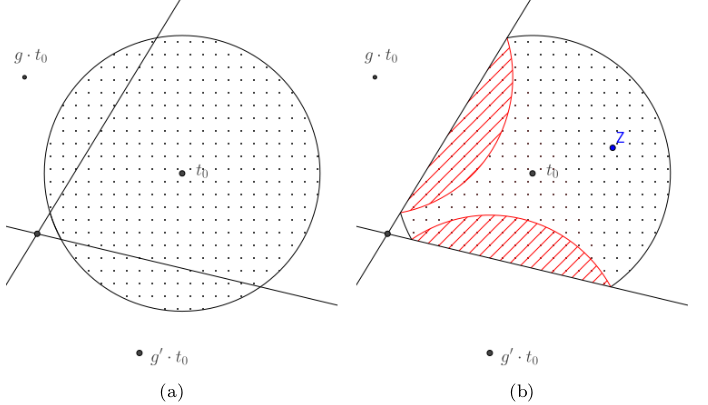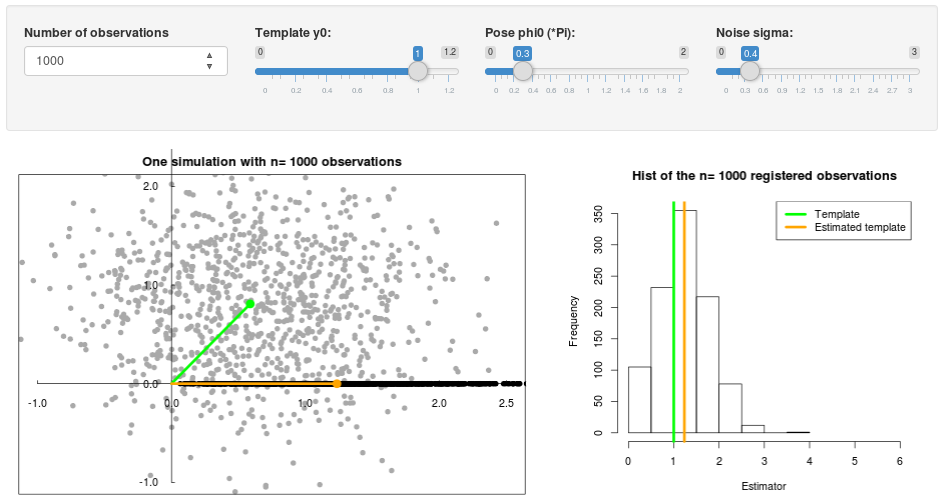Section: New Results
Computational Anatomy
Inconsistency of the Estimation of the Template in Quotient Spaces
Participants : Loïc Devilliers [Correspondant] , Stéphanie Allassonnière [Ecole Polytechnique] , Alain Trouvé [ENS Cachan] , Xavier Pennec.
Atlas computation, Template estimation, Fréchet mean, Quotient spaces, Inconsistency.
One issue in computational anatomy is to compute a template (a prototype of our data) in presence of two effects: an unknown deformation on data and the noise due to error in measurement in the ambient space considered here as an infinite dimensional linear space. The template computation can be done by minimizing an energy function (or variance) in the quotient space. In [50], we show that this method can lead to inconsistency that we quantify (see Fig. 6). This paves the way to a better understanding of the geometric and statistic foundation of the template estimation.
|
Geometric Statistics for Computational Anatomy
Participants : Nina Miolane [Correspondent] , Xavier Pennec.
This work is conducted jointly with the Department of Statistics of Stanford, in the context of the associated team GeomStats of the program Inria@SiliconValley.
Statistics, Computational anatomy, Differential geometry, Template shape, Asymptotic bias.
-
First, we have shown in [52] that the usual algorithm of template organ shape estimation is biased (see Fig. 7). We proposed two bootstrap procedures that quantify the bias and correct it.
-
In [53], we unified the template estimation problem with a manifold learning problem. We showed how the Bayesian framework enables correction in cases that are pathological if only the Maximum Likelihood estimator is used.
|
Barycentric Subspace Analysis: a new Symmetric Group-Wise Paradigm for Cardiac Motion Tracking
Participants : Marc-Michel Rohé [Correspondant] , Maxime Sermesant, Xavier Pennec.
The authors acknowledge the partial funding by the EU FP7-funded project MD-Paedigree (Grant Agreement 600932).
Low-dimensional analysis, Cardiac motion, Registration, Image synthesis.
We propose a novel approach to study cardiac motion in 4D image sequences using low-dimensional subspace analysis [43]. Instead of building subspaces relying on a mean value we use a novel type of subspaces called Barycentric Subspaces, which are are implicitly defined based on reference images instead of being defined with respect to one reference image. This allows:
-
First: to build low-dimensional representation of the cardiac motion signature which actually separates perfectly two different populations.
-
Second: to build a better prior for the cardiac motion tracking, which improves the registration accuracy at end-systole by 30%.
-
Third: to reconstruct the sequence of images with better accuracy than traditional single reference methods.
Compact Representation of Longitudinal Deformations
Participants : Raphaël Sivera [Correspondant] , Hervé Delingette, Xavier Pennec, Nicholas Ayache.
Longitudinal modeling, Learning in manifolds, Structured sparsity.
The use of a comprehensive and meaningful decomposition of a set of structural transformations would be useful to describe evolutions and to enhance diagnosis. In this context, we aim to model the brain anatomical evolution which goes along the Alzheimer's neurodegenerative disease. Based on the Stationary Velocity Fields representation of diffeomorphisms, we proposed a description of deformations in both space and time. The objective is to go beyond simple discriminative approaches (see Fig. 9) to propose a synthetic description of the disease evolution, population and subject-wise.





